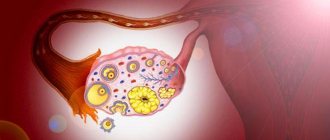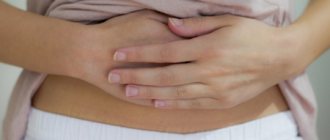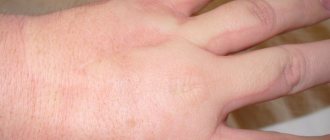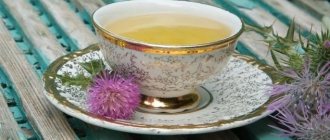Reflux esophagitis is an inflammation of the mucous membrane of the esophagus, which causes acid reflux (pathological reflux of contents from the stomach into the esophagus), ICD-10 code: K21.0.: gastroesophageal reflux disease with esophagitis, GERD. There are two types of GERD: erosive and non-erosive. The form with esophagitis belongs to the first type.
Inflammation of the esophageal mucosa
When a person swallows food, the lower esophageal sphincter, which separates the stomach and esophagus, opens, allowing food and liquid to enter the stomach. Then it closes again. If this process is disrupted, gastric juice flows back into the esophagus. The constant reflux of acid into the esophagus and throat caused by reflux damages the mucous membrane, causing inflammation, which leads to heartburn and nausea.
Gastroesophagitis is often accompanied by a disease such as duodenogastric reflux (reflux of duodenal contents and bile into the stomach), which aggravates the course of GERD. The following reasons lead to this:
- Increased intragastric pressure, which increases the likelihood of reflux esophagitis.
- Increased aggressiveness of gastric juice and acidity, which causes bile reflux.
Treatment of reflux esophagitis with folk remedies
Such an unpleasant disease as reflux esophagitis appears due to the return of undigested food into the esophagus with gastric juice. Hydrochloric acid irritates the walls of the esophagus and provokes inflammation. The disease is accompanied by certain symptoms - heartburn, nausea, belching, sore throat and even vomiting. Often, reflux treatment is carried out using conservative methods, but at the same time, healing with folk recipes is also practiced.
Types of disease
Clinical forms:
- Chronic reflux inflammation of the esophagus is accompanied by periodic painful sensations behind the sternum. Symptoms intensify when running, lifting weights, or eating.
- Acute reflux esophagitis is characterized by inflammatory changes directly in the esophageal wall. When a person takes food, he feels that the movement of the food bolus stops behind the sternum. At the same time, the temperature rises, salivation increases, and swallowing problems occur. Belching is observed in the final stage of the disease.
Non-erosive reflux esophagitis
What is non-erosive reflux esophagitis? This complex term refers to one of the types of GERD, characterized by specific clinical symptoms, in the absence of damage to the tissues of the esophagus. Serious therapy is usually not needed. As a rule, patients recover after normalizing their diet and eliminating spicy, fatty and salty foods.
Erosive reflux esophagitis
The erosive form is one of the most dangerous, because with it the mucous membrane begins to become covered with ulcers. If left untreated, they can bleed or lead to more serious consequences. The worsening of the disease is provoked by dietary errors, which include the consumption of various types of acidic foods, caffeine and alcohol.
Often the course of the disease is aggravated by medications, even such harmless ones, at first glance, as paracetamol, analgin, aspirin, etc. The disease can occur without symptoms for a long time or have the same symptoms as gastritis.
If left untreated, this disease can affect not only the upper cells of the esophagus, but also the deeper layers. Therefore, treatment is carried out under the strict supervision of a doctor.
What it is
Reflux esophagitis occurs quite often, and the risk of the disease increases with age. If the disease is not treated, it will lead to chronic inflammation of the esophagus, damage to the mucous membrane, erosive esophagitis and even cancer. The reason for the appearance of the presented disease lies in the uncontrolled frequent opening of the esophageal sphincter at the entrance to the stomach. It is usually held in a compressed position and opens for 6-10 seconds, allowing food and water to move into the stomach. When the sphincter remains relaxed longer, acidic gastric juice escapes into the esophagus. Reflux often develops after gastric surgery. Other factors that provoke the disease are:
- smoking;
- alcohol abuse;
- excessive coffee consumption.
In obese people, the stomach puts pressure on the diaphragm, which also causes involuntary relaxation of the sphincter.
Symptoms of reflux gastritis
For a long time, the signs of the disease are mild. Only when reflux gastritis progresses do the symptoms begin to bother the patient. If they appear, you should contact a specialist for timely diagnosis and treatment. Inflammation of the stomach, which is accompanied by the reflux of food chyme from the duodenum, is characterized by the following manifestations:
- aching pain and discomfort after eating;
- feeling of heaviness in the upper abdomen;
- belching sour or bitter;
- vomiting mixed with partially digested food;
- loss of body weight;
- nausea;
- changes in stool such as diarrhea or constipation.
If reflux gastritis is accompanied by dysfunction of the biliary tract, there is a reflux of bile into the stomach. The presence of bile acids causes a specific inflammatory process, in which a bitter taste in the mouth and vomiting mixed with bile are noted.
Symptoms of reflux esophagitis
In case of insufficiency of the sphincter of the cardial part of the stomach, reflux of gastric contents into the esophagus is observed.
This often occurs during sleep, when a person is in a horizontal position, during pregnancy. Reflux gastritis with reflux esophagitis gradually develops with the following clinical signs:
- heartburn in the evening or at night;
- belching sour or bitter;
- a feeling of a lump and pain behind the sternum, radiating to the back, neck, which intensifies with physical activity, jumping, forced breathing;
- frequent hiccups;
- drooling;
- cough;
- shortness of breath.
The aggressive effect of hydrochloric acid on the mucous membrane of the esophagus eventually leads to scarring and narrowing.
Symptoms of duodenitis
The inflammatory reaction in the duodenum is rarely isolated. Basically, there is a chronic course of the disease, which occurs against the background of dysfunction of the sphincters of the gastrointestinal tract. Symptoms of reflux gastritis are accompanied by manifestations of duodenitis (inflammation of the duodenum) and bulbitis (inflammatory process in the duodenal bulb):
- discomfort in the upper abdomen after eating;
- pain on palpation of the pyloroduodenal area;
- flatulence;
- decreased appetite;
- nonspecific signs such as irritability, increased fatigue.
Tried and tested tips
At the initial stage of the disease, discomfort and burning sensation are felt in the esophagus. Having discovered such signs in yourself, which are repeated periodically, you should immediately take action to correct the situation. You should change your habits, listen to the recommendations and, if possible, follow them daily:
- First you need to change your diet. It is necessary to give up coffee, chocolate, fatty foods and alcoholic drinks.
- It is important to give up all foods that cause bloating - gas formation in the intestines can involuntarily lead to the rise of all organs of the gastrointestinal tract.
- You should not drink red wine, soda, flavor your dishes with spicy seasonings, or eat citrus fruits, because they stimulate increased secretion of gastric juice.
- It is necessary to reduce portions, but eat more often. Overeating provokes the production of excess enzymes, which leads to the release of food back.
- You can alleviate the symptoms of the disease by sitting at a table in an upright position, rather than leaning over the table.
- Learn to sleep on high pillows.
- Obese people should lose weight; less obese people may also need to lose weight. Even slight excess weight can provoke unpleasant symptoms.
In the later stages of the disease, the use of folk recipes will help alleviate the patient’s condition, restore the functioning of the sphincter and protect the walls of the esophagus. Before you start treatment, you should definitely visit your doctor and consult.
Diagnostics
Daily pH monitoring. A special probe with a device that measures acidity for 24 hours or more is inserted into the gastrointestinal tract through the nose. At this time, the patient leads a normal lifestyle. pH-metry accurately detects the presence of reflux, the duration and frequency of episodes, and helps determine the effect of certain actions (eating, smoking, exercise, sleep) on changes in acidity levels. The results help to individually select a treatment method.
Radiography
A radiological research method that makes it possible to visualize the structure of the esophagus, stomach and duodenum. Before passing, the subject takes a contrast agent (Barium Sulfate BaSO4) orally. The person is then exposed to x-rays and pictures are taken. This is a proven and safe procedure that does not require internal intervention.
Gastroscopy
A type of endoscopy. The doctor inserts an endoscope into the mouth, pushing it into the stomach. Then he carefully examines the condition of the mucous membranes of the organs being studied. If necessary, a biopsy (removal of a tissue sample for detailed laboratory analysis) is performed.
Gastroscopy is the most detailed type of diagnosis, providing accuracy that other types of research cannot provide. Its characteristics allow you to quickly establish an accurate diagnosis.
Gastroesophagomanometry
Manometry is the measurement of intraesophageal pressure during swallowing. A thin catheter with special sensors is inserted into the esophagus through the nose. The results of the study are used to determine the pressure in the area of the esophageal sphincters and the work of peristalsis. Problems associated with gastrointestinal motility and impaired functioning of the lower esophageal sphincter play a key role in the development of reflux, which makes manometry an extremely important method.
Traditional treatment for reflux
Treatment of esophagitis with folk remedies involves the use of herbal preparations and natural products. If you act correctly, they will help cure reflux, namely:
- Reduce the release of hydrochloric acid.
- Normalize stomach acidity.
- Restore sphincter tone.
- Eliminate unpleasant symptoms.
- Relieve inflammation of the esophageal mucosa.
It is important to know that not every medication and herbal infusion is compatible with each other. In addition, many medications contain plant extracts, so you should be careful when treating with herbs so as not to overdo it.
If a person has GERD and esophagitis - gastroesophageal reflux - it is forbidden to take herbal tinctures with alcohol and use folk recipes using alcohol. It only aggravates inflammation because it irritates the mucous membrane. Herbal treatment helps a lot - decoctions can be made from one plant or from their collections. The following recipes are especially popular.
Chamomile
This herb is used for esophagitis that has become chronic. A remedy with chamomile relieves inflammation, disinfects the mucous membrane and heals the affected surface of the esophagus. To cure erosions, you need to drink chamomile tea. You can buy dry herb at a pharmacy and brew it 1-2 tablespoons in a glass of boiling water. Drink tea warm, but not hot.
Flax seeds
The medicinal product from flax seeds is taken as an enveloping substance. They are considered the most effective preventive medicine against gastrointestinal ulcers and oncology. Flax seeds reduce stomach acidity and relieve unpleasant symptoms. You can prepare a healing remedy by brewing 20 g of seeds in ½ glass of hot water. Leave it on all night and drink the resulting mixture in the morning. The duration of treatment is a week, then rest for 5 days and repeat the course.
For treatment, it is better to take varieties of honey that are well absorbed by the body. Honey should be taken before meals, preferably 1-2 hours before meals. Honey should be diluted with a small amount of water. The duration of treatment is two months. During an exacerbation, it is not recommended to treat with honey; it will only add irritation to the mucous membrane. For the same reason, honey is diluted with water.
Sea buckthorn oil
Sea buckthorn oil helps heal damage to the walls of the esophagus, normalize secretory function, improve the digestion process and increase bile secretion. You need to drink a teaspoon before meals. Therapy for esophageal esophagitis lasts at least two weeks. In addition, sea buckthorn relieves inflammation and pain.
Causes of the disease
The most common causes of reflux - esophagitis are poor diet, prolonged alcohol consumption and very spicy foods. With improper treatment or its absence, scars form on the walls of the esophagus. Reflux can also occur due to muscle weakening, when the valve begins to leak gastric juice.
The most common causes of esophagitis are:
- high pressure and distension in the peritoneum;
- improper diet;
- spicy, smoked and fatty dishes;
- stress;
- chemical factors;
- obesity;
- ulcers;
- period of bearing a child;
- excessive drinking;
- smoking.
Any of these factors can lead to exacerbation and return of the disease. Even a simple bend forward is enough for this.
Features of the disease
The mucous membrane of the esophagus is affected due to chronic, periodically repeated reflux of acidic stomach contents into the esophagus. But this is not the only cause of esophagitis, the occurrence of which is facilitated by:
- infections;
- chemical burns;
- atony of the esophageal sphincter;
- disruption of the stomach;
- strong feelings;
- pregnancy;
- inclined body position for a long time;
- excess weight;
- smoking;
- taking medications that increase dopamine levels in the blood.
At the site of damage to the esophageal tube, experts distinguish total esophagitis, which develops throughout the entire mucous membrane of the organ, proximal, which appears at the beginning, and distal, which occurs in the lower part of the esophagus. The latter is observed most often. It occurs in adults, but also occurs in children.
Recommendations for patients with gastroesophageal reflux
Patients with GER are advised to adhere to certain rules to avoid reflux of gastric contents into the esophagus:
- refuse tight clothing, corsets, and do not wear belts or belts;
- give up alcohol and smoking;
- exclude from the diet foods that reduce the tone of the lower esophageal sphincter (fats, chocolate, peppermint, tomatoes and products based on them, orange and pineapple juice);
- give up chewing gum and lozenges;
- do not lie down for 2–4 hours after eating;
- raise the head of the bed by 10–15 centimeters;
- If you are overweight, then you need to lose weight.
Signs of the disease
Symptoms of reflux esophagitis depend on its type, the degree of development and form of the disease, as shown in the table.
| Form | Symptoms |
| Acute | Pain when passing food. Belching. Swallowing disorder. Burning. Increased body temperature. Malaise. |
| Chronic | Pain behind the sternum - not necessarily during eating. Urges of nausea. Vomit. Hiccups. Increased salivation. |
Treatment of reflux esophagitis is prescribed after examination and confirmation of the diagnosis. The doctor chooses treatment methods after determining the type of disease.
Most often, catarrhal (with swelling and redness of the esophageal tube) and erosive (with acute infections) esophagitis occur. Official medicine uses different treatment methods for each type: with drugs and surgery.
The patient must take into account: in order to recover, you need to completely change your lifestyle, especially your diet.
Symptoms
Clinical manifestations of the disease are divided into two groups: esophageal and extraesophageal. In adults, typical symptoms of the first group include heartburn, indigestion, sour taste, regurgitation and chest pain that worsens when the person has eaten, lies stomach down or bends forward. Extrophageal (atypical) symptoms include cough, lump in the throat, mucus in the mouth, reflux pharyngitis and hoarseness; in the acute course of the disease, the temperature rises. Children and infants may experience the following symptoms: repeated nausea, vomiting and cough.
The pain that occurs with esophagitis is often confused with heart pain, which is due to the close location of the corresponding nerve endings. This phenomenon is called cardiac syndrome. Against the background of the underlying disease, non-obstructive bronchitis often develops.
Cure at home
To get rid of all the symptoms of reflux esophagitis, many use folk remedies. This is an effective alternative to taking pills and undergoing procedures. The most effective recipes use natural raw materials: herbal infusions, decoctions, teas.
The therapeutic effect of a homemade infusion only lasts for 24 hours - you need to prepare a fresh one every day.
- Dill infusion
. This soothing medicine will help relieve inflammation characteristic of the acute form of the disease. You just need to prepare the seeds of this plant in the fall or purchase them at the pharmacy. To prepare the infusion, pour 200 ml of boiling water into 6 g (2 tablespoons) of dill seeds, crush and leave to infuse for three hours. The daily consumption regimen is 4 times a tablespoon.
How to recover easier?
Treatment of the disease with folk remedies is most often prescribed in combination with drug therapy. But any specialist will also focus on the patient’s proper nutrition. Not even the most effective medicine will be beneficial if you do not follow a diet. It is necessary to exclude fried and smoked, salted and pickled foods from the menu.
The use of recipes created by our ancestors should be supervised by the attending physician. After all, some of them can cause complications. These are recipes with the addition of hot alcohol, alcohol or vodka, which will cause even more severe irritation of the esophageal mucosa. If you follow all the recommendations, homemade recipes will help you regain your health.
Treatment of bile reflux
Bile reflux is a consequence of pathological processes or diseases in the body. It does not arise on its own. Diagnosis is an important stage in the treatment of reverse bile reflux.
Before starting therapy, it is important to find out the cause, eliminate it, and only then restore the normal flow of digestive fluid.
In medical practice, there are several ways to treat bile reflux. Some traditional medicine methods are also effective.
Medicines for the treatment of bile reflux
Every patient must remember that drug treatment is possible only with a doctor’s prescription. Any self-prescription and uncontrolled withdrawal of symptoms can lead to very serious consequences.
Medicines prescribed by a doctor:
- selective prokinetic - a drug that increases muscle tone of the sphincters. Motilium and Cerucal normalize gastrointestinal motility;
- medications to reduce acidity levels. Antacids Maalox and Almagel;
- medications that reduce the toxicity of bile acids. These include Ursofalk, which converts the components of bile into less harmful water-soluble compounds. The active ingredient is ursodeoxycholic acid;
- medications such as Omeprozole, which inhibits the production of hydrochloric acid by the secretory glands of the stomach;
- Magnesium sulfate improves the functioning of the gallbladder.
Maalox
Motilium
Omeprazole
Ursofalk
Any of these drugs is not a 100% cure for bile reflux. Each remedy is used in complex therapy. Medicines are prescribed by a doctor who sees the full picture, the causes of the pathogenic bile flow. Based on these data, he prescribes drug therapy.
Surgery
Operations are performed mainly when bile reflux occurs due to pressure from a foreign formation. If it is a hernia, it is simply removed, just like neoplasms of different nature.
Until recently, the only treatment for backflow of digestive fluids into the esophagus was drug therapy. Complex therapy for bile reflux is associated with some inconveniences. The valve defect led to the fact that the patient was forced to take inhibitors of hydrochloric acid production or those that reduce the toxic effects of bile acids throughout his life.
Not all patients tolerate these medications equally well. In addition, when taking them, a strict diet is prescribed. There is only one way out of the situation - surgical intervention.
Minimally invasive surgery techniques are very effective in this case. The operations are performed using a laparoscope through small holes. The result of surgical manipulations is the replacement of the defective sphincter. Relief and complete relief from symptoms occurs immediately after surgery. The incisions in the skin are so small that in most cases they do not even leave scars.
Alternative Treatments for Bile Reflux
Some experts consider diet and some recommendations to be an effective non-drug method for treating bile reflux. With dietary treatment, the disease itself does not go away, but its symptoms are alleviated. You should not drink carbonated drinks, fatty, salty, spicy, fried foods. Reduce the use of alcohol and tobacco to zero.
Alternative methods also include acupuncture. This is an ancient Chinese technique that has proven to be quite effective in treating bile reflux.
Phytotherapy
Juices and infusions help in the treatment of bile reflux. But they can only be used with the permission of a doctor in combination with medications. Most often recommended are dandelion syrup, infusion of mint, St. John's wort, yarrow, and potato juice.
To prevent surgery, it is necessary to begin treatment for reverse bile reflux in the early stages . When the gastric mucosa is not yet damaged and the esophagus is not damaged, treatment is more effective, faster and painless.
Therapy at home
In case of GERD, treatment is carried out after consultation with the attending physician. Self-prescribing medications or home remedies is prohibited.
Healers recommend drinking cold cow's milk every day on an empty stomach; it helps reduce the concentration of acid in the lumen of the stomach. However, you cannot get carried away with this remedy. There is an opinion that milk in large quantities enhances symptoms.
The following remedies will help cure GERD:
- Raw almonds. It envelops, relieves pain and relieves spasms. You are allowed to take almond oil.
- You need to take 60 ml of aloe vera juice.
- Start your morning with a glass of warm liquid (preferably water) and freshly squeezed lemon juice. You should drink on an empty stomach 15–20 minutes before meals.
- Onions with sugar. Take red onion, grate it on a fine grater, add 1 tbsp. l. granulated sugar. The medicine needs to stand for 10 minutes, then it needs to be mixed. This remedy should be taken on an empty stomach and after meals. Duration of therapy is 2 months.
- Add 1 tbsp to 150 ml of water. l. baking soda - not tasty, but effective for GERD.
- It is recommended to take 1–2 tsp. apple cider vinegar daily. You can mix it with honey to make the taste more pleasant and not burn, or add it to tea instead of lemon.
- After fatty, smoked and other dishes that cause symptoms of GERD, you need to eat 1 red apple.
- A cup of peppermint tea can help relieve acid reflux.
- Tea made from chamomile, mint or fenugreek helps a lot. 1 tsp is enough. per glass of water and leave for 10 minutes.
Studies have shown that sleeping on the left side will provide relief to patients diagnosed with gastroesophageal reflux disease.
How and with what to treat reflux esophagitis
After making a diagnosis and determining the degree and severity of the process, the doctor prescribes individually suitable treatment for each patient. You should not engage in therapy on your own without the supervision of a specialist, as this can lead to aggravation of the disease and complications.
The most significant point in the treatment of esophagitis is diet.
What should be the diet for reflux esophagitis?
The diet should be divided into six meals a day in small portions. This kind of nutrition is called fractional. It provides balance and the necessary energy potential for a person. The last meal should be taken four hours before bedtime.
Why should portions be small in volume?
The whole point is that the stomach should not be full during food. When eating a large amount of food, the walls of the organ become overstretched, resulting in incomplete closure of the sphincter valves and backflow of the contents into the esophagus.
- After eating, it is forbidden to lean forward, engage in physical activity, or lie down until 1 hour has passed. This is due to intra-abdominal pressure.
- Patients with this diagnosis should not lift weights or engage in strength sports.
- You should only wear loose clothing that will not create a pressing effect on the chest and abdominal area.
- If a person is overweight, then it is imperative to lose weight.
- You should sleep with the head of the bed raised.
Which products are strictly prohibited for consumption:
- Alcohol, tobacco.
- Soda, freshly squeezed concentrated juices.
- Strong tea, coffee.
- Fatty broths.
- Smoked, salted, dried, fried foods.
- Citrus fruit.
- Spices, paprika, soy sauce.
- Legumes, black bread, cabbage.
- Chocolate, spices, sweet flour products.
- Chewing gum.
- Canned food, canned goods.
- Pasta, spaghetti, pasta.
- Fast food.
List of products allowed for consumption:
- A chicken egg, but not fried or raw, but boiled.
- Milk, cottage cheese with a low percentage of fat content.
- Porridge cooked in water or milk.
- Boiled meat, fish.
- Cutlets, meatballs without frying, steamed.
- Boiled potatoes, vegetables.
- Low-fat soups and broths.
- Raw vegetables and fruits: carrots, sweet apples, bananas.
- Weak tea.
Drug treatment
In addition to diet therapy, medications are prescribed. If the stage and degree of the course have not progressed to a critical state, surgical intervention is not resorted to.
The basis for the treatment of esophageal reflux is the administration of proton pump inhibitors. The dosage and frequency of administration are prescribed by the doctor individually, depending on the characteristics of the patient’s body.
Omeprazole, Omez, Emanera, Lansoprazole and other analogues are prescribed.
Antacids are used to inactivate the aggressive acidic environment. The liquid or soluble form is also selected individually. Examples: Almagel, Maalox, Phosphalugel and others.
To eliminate pain symptoms, intestinal antispasmodics are prescribed: D.spatalin, Drotaverine, Papaverine.
For nausea and vomiting - prokinetics. Metoclopramide is most often used.
To eliminate intoxication, adsorbents can be used: Activated carbon, Polysorb.
In order to restore and improve microflora: probiotics - Linex, Normobakt, Enterol.
Patients are often interested in how long it takes to treat reflux esophagitis and whether it can be cured completely.
If the impact of the damaging factor is one-time and the degree of impact is minimal, then a complete cure is possible.
On the other hand, when the process becomes chronic, cure is completely difficult. It is possible to achieve long-term remission with medication and pharmacology, and the symptoms will never return.
A diet for this disease should be followed for life and lead a healthy lifestyle. The course of drug therapy can last from 1 month to six months. All this is determined by the doctor.
Surgery
This type of therapy must be resorted to in cases where:
- Drug treatment is ineffective;
- Serious complications arise: bleeding, cancer, perforation.
- Aspiration injuries to the lungs appear.
- Severe forms of the disease.
The operation and recovery period are carried out in a hospital under the supervision of qualified specialists.
Herbal medicines
Treatment with folk remedies has proven effective for GERD. The reason is clear - natural ingredients.
Home remedies recommended for GERD treatment:
- To prepare the medicine you will need 24 g of crushed plantain leaves, 4.4 g of chamomile flowers and 20.4 g of St. John's wort. The broth is simmered over low heat for 25 minutes. Drink 1 tbsp. l. 3 times a day.
- Flaxseed decoction. Add 4 g of seed to 200 ml of boiling water and boil for 5 minutes. The medicine is infused for 30 minutes, 0.5 tbsp is consumed. l. three times a day.
- Plants such as chamomile, St. John's wort, sea buckthorn, and lemon balm are taken in equal quantities. Place 1 tbsp in 200 ml of boiling water. l. herbal collection. You can drink the decoction 10 minutes after infusion.
- Mix 2 tbsp. l. calendula, 1 tbsp. l. chamomile, 14 tbsp. l. coltsfoot leaves. Take 2 tbsp. l. collection, pour a glass of boiling water. Infuse the product for half an hour. Drink 1 tbsp 20 minutes before meals. l. The frequency of use per day is 3–4 times.
- Yarrow and St. John's wort herbs are taken in equal amounts. Approximately 60 g of the collection is poured into 0.5 liters of vodka. The medicine is infused for 10 days. Use 1 tbsp. l. after every meal.
Treatment of the disease with traditional methods does not end with herbal medicine. It is possible to use mineral waters. The best are alkaline low-mineralized waters, namely “Borjomi”, “Slavyanovskaya”.
Doctors recognize that traditional medicine helps cure GERD. However, you should first consult with a specialist, despite the safety of the medicine used.
Reflux gastritis: treatment
The main principle of helping with the disease is an integrated approach to therapy. If chronic gastritis, reflux esophagitis, or duodenitis occurs, treatment is prescribed by a gastroenterologist based on the diagnostic results. The first step on the path to recovery is a properly organized diet, which includes special nutrition. The protocol provides for drug therapy with drugs and physiotherapeutic methods. The treatment regimen is aimed at eliminating the etiological causes and pathogenetic mechanisms of the development of the disease, preventing exacerbation of the condition.
Drug treatment
The main focus of the protocol is a treatment regimen, which is carried out medicinally - with tablets and other forms of release for oral administration of the drug. Treatment of gastritis and reflux esophagitis includes groups of drugs that eliminate the symptoms of the disease and restore the functioning of the digestive tract.
Table 2. Drugs for the treatment of reflux gastritis
| Groups of medications | Drug names | Therapeutic effect |
| Antisecretory substances | Pantoprazole, Omeprazole, Omez, Nolpaza, Lansoprazole | Reduces hydrochloric acid production |
| Antacids | Phosphalugel, Maalox, Almagel | Create a protective layer on the surface of the mucous membrane, reduce the aggressive effect of secretions in a hyperacid state |
| Alginates | Gaviscon, Sodium alginate | Reacting with hydrochloric acid, it forms a gel base on the surface of the epithelium with a neutral pH level |
| Prokinetics | Motilium, Domrid | Normalizes intestinal motility, prevents the reflux of intestinal contents into the stomach and esophagus, reduces the symptoms of nausea and vomiting |
| Ursodeoxycholic acid | Ursofalk, Ursosan | Reduces cholesterol secretion, replaces the toxic form of bile acids with a non-toxic one |
| Bismuth preparations | De-nol | Shows antimicrobial and astringent effect |
| Gastroprotectors | Sucralfate | Forms a film on the surface of the mucous membrane, preventing the return of bile, pepsin and hydrochloric acid |
| Antibacterial agents | Antibiotics of the penicillin, macrolide, rifampicin group | Destroy Helicobacter pylori |
Diet for reflux gastritis
Gastroenterologists pay special attention to the diet of patients with preudenal gastric reflux (DGR). Therapeutic nutrition for reflux gastritis is aimed at preventing the reflux of food into the upper parts of the digestive tract. A menu is prescribed according to table No. 5. It is recommended to adhere to fractional meals in order to ensure complete digestion of food and reduce stagnation of the food bolus in the stomach. The list of permitted and prohibited products is presented in Table 3.
Table 3. Nutrition for reflux gastritis
| What can you eat | What not to eat |
| Vegetable broth soups with any cereals | Fish, beef, mushroom broth, borscht, cabbage soup |
| Cutlets, meatballs, boiled or steamed meatballs | Fried cutlets, meat, especially fatty varieties, smoked meat products, sausages |
| Low-fat fish varieties - pike perch, carp, hake | Fish with a high fat content - salmon, salmon, pelengas, belan |
| Baked, boiled potatoes | Fried potatoes |
| Wheat bread, dried | Rye bread, sweet yeast baked goods |
| Soufflé or egg omelet | Scrambled eggs |
| Non-acidic cottage cheese, curdled milk, sour cream, low-fat milk | Kefir, sour yogurt, fatty cheese, fermented baked milk |
| Steamed vegetables | Thermally unprocessed vegetables, including cabbage, radishes, onions, radishes, tomatoes |
| Fruits with a neutral taste - apples, pears, peaches, plums | Sour berries, fruits, citrus fruits |
| Kissels and compotes | Carbonated drinks, juices, fresh juices, coffee, strong tea, cocoa, honey, jam |
Important! Before main meals, you should drink a glass of water at room temperature to reduce the concentration of hydrochloric acid in the stomach.
Treatment of reflux gastritis with folk remedies
Along with traditional therapy, experts recommend alternative medicine. Natural products have long been used to relieve symptoms of diseases and normalize the functioning of the gastrointestinal tract. When treating reflux gastritis with folk remedies, the most effective drugs and recipes are based on herbal ingredients. Recipes are presented in Table 4.
Table 4. Traditional methods of treating reflux gastritis
| Medicinal substance | Admission rules |
| A mixture of mint, anise, calamus root, oregano herb | Mix a tablespoon of each component, add 400 ml of water and leave in a water bath for 20 minutes. Take 6 times a day, 100 ml |
| Sea buckthorn oil | Drink 1 teaspoon before meals |
| Flax seed with chamomile and licorice root | Combine 2 tablespoons of chamomile seeds and flowers with 1 tablespoon of licorice root. Pour 500 ml of boiling water and leave for an hour. Take half a glass 3 times a day |
| Rose hip decoction | A tablespoon of berries is poured into a glass of boiling water and left for 2 hours. The product has a bactericidal effect and is useful in hypoacid conditions |
| Dandelions | Plants are sprinkled with sugar. The resulting juice is taken 1 teaspoon 3 times a day, after dissolving it in water |
Mineral water for reflux esophagitis and gastritis
Mineral water is an effective preventive and therapeutic agent for inflammatory processes of the digestive tract associated with the reflux of contents. A special composition of natural origin alleviates unpleasant symptoms, improves digestion and motor function of organs. Sulfate calcium-magnesium, sodium-calcium-chloride waters are suitable. The following types of sources help treat reflux gastritis:
- Truskavetskaya - Sofia, Maria;
- Morshynskaya;
- Essentuki 4;
- Borjomi;
- Azovskaya;
- Kazachinskaya.











